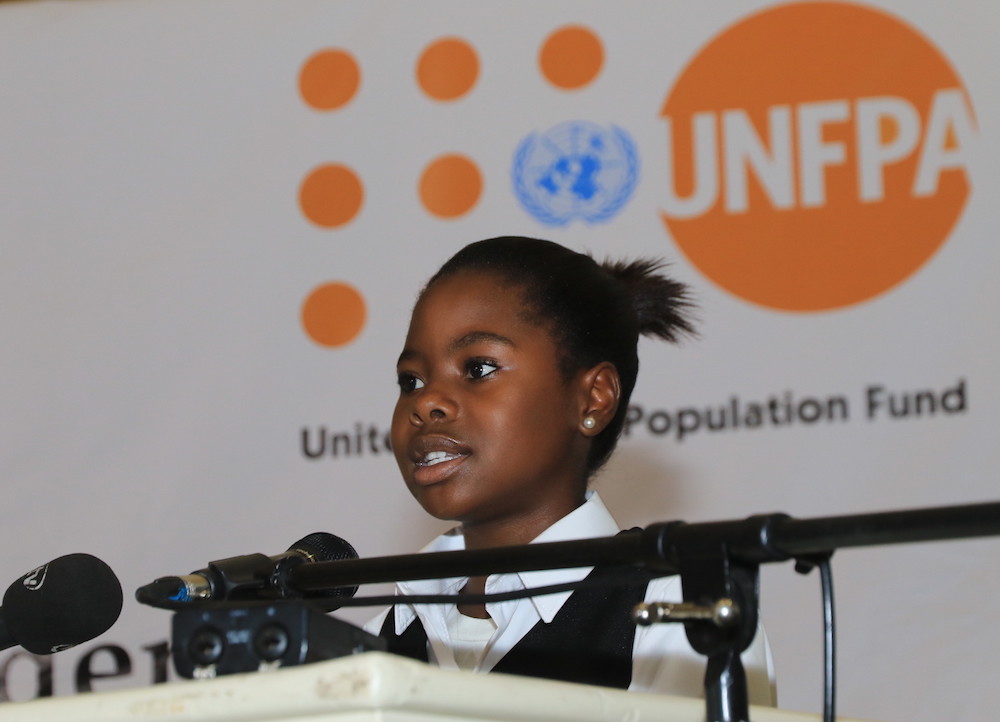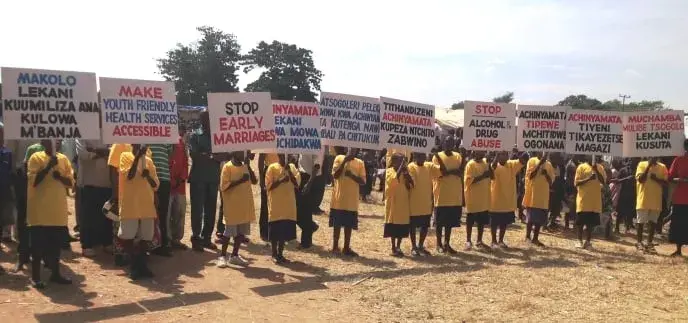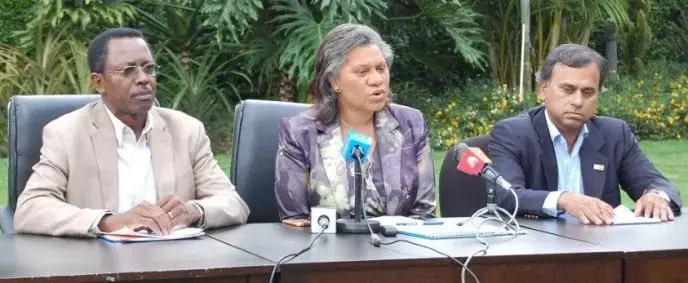A demographic dividend is not only contingent on a rapid decline in fertility and mortality. It also requires strategic investments in promoting equality, health and family planning, education and skills development, and job creation. When countries harness the demographic dividend, their young people become more empowered, healthier, better educated and have more equal access to opportunities.
On March 16, Botswana became one of a dozen countries in East and Southern Africa that have launched its national Demographic Dividend study, at a milestone event officiated by the then-incoming President, the Honourable Mokgweetsi EK Masisi. In doing so, the nation translated the commitment made by African Heads of States at the 29th African Union Summit, themed “Harnessing the Demographic Dividend through investment in Youth”, into a national demographic dividend profile.

Eleven-year-old Zandile Munamati's passionate statement on her aspirations for a promising future was one of the highlights of the launch event. Zandile dreams of becoming a medical doctor and contributing to the growth of her country, alongside her peers. She wants to see Botswana become a highly developed nation, like Norway, South Korea or Singapore. Zandile represents the story of Batswana youth, against the unfolding demographic dividend.
Her dreams are in line with Botswana’s vision 2036 – an appeal for Botswana to manage its path to ‘Prosperity for All’, as well as to adjust to the rapidly changing global economy and social order.
Does Botswana have it all?
To the outside world, Botswana seems to have it all.
This nation is a poster child for political stability in Africa, thanks to its unblemished record of good governance, accountability and peace in the SADC region.
With a population of just over 2 million people, which is projected to rise to 3.4 million by 2050, this nation is a poster child for political stability in Africa, thanks to its unblemished record of good governance, accountability and peace in the SADC region.

An upper-middle-income country with an admirable history of economic prosperity as a result of its successful agricultural and mining industries, it is also one the few African countries in which education is free or heavily subsidized at primary, secondary and tertiary levels.
At independence in 1966, Botswana was not what it is today. It was part of the league of developing countries.
Fast forward 52 years post independence, and Botswana’s investments in child health and family planning have played a key role in fertility decline, an unprecedented outcome on the African continent, where most countries are still struggling with high birth rates. The average number of births per woman across the continent stands at 5 children, while in Botswana the figure numbers just 2.7 births per woman.
More than meets the eye
At the launch of the nation's Demographic Dividend study, Opportunities and Actions to Maximize the Demographic Dividend in Botswana, Dr. Eliya Zulu from AFIDEP presented the findings. These attested to the fact that, indeed, there is more to Botswana than meets the eye.
Despite Botswana’s impressive economic performance, upper-middle-income status and success in poverty reduction, the country’s development record is below its potential.
According to the report, “Despite Botswana’s impressive economic performance, upper-middle-income status and success in poverty reduction, the country’s development record is below its potential. Income inequality in Botswana is among the highest in the world.”
After massive investments in education (more than 20 per cent of the national budget) Botswana appears to question whether the cumulative investments have yielded the expected returns. High unemployment levels are prevalent among youth, both educated and non-educated, as a result of job scarcity.
On average, Batswana youth remain dependants until the age of 32 years and only begin to create a surplus in the economy from age 33 years.

The long ‘waithood’ (the gap in years between when a young person graduates to when they land their first job) has a significantly negative impact on the national economy, and this can’t be ignored. According to the report, “If Botswana were to invest to increase average annual labour productivity by 0.5 per cent annually, it could achieve a 14 per cent higher income per capita by 2050.”
Much progress has been made by the Botswana government in its national response to HIV, which includes the roll-out of testing and treatment programmes. Notwithstanding this, the nation continues its long battle with HIV. With a national prevalence rate of 17 per cent, HIV remains a significant health concern. For young people between the ages of 15 to 24 years, the prevalence variance for young girls is almost 11 per cent, as compared to their male counterparts (nearly 5 per cent).
In their quest to earn a living, young girls and women engage in transactional sex relationships with older, wealthier men (commonly referred to as sugar daddies or blessers) in exchange for money, food, and gifts. This exposes them to HIV infection and unplanned pregnancies.
When a girl is not in school, she misses out on opportunities to gain knowledge and skills that may help her realize her potential in life.
The worrying trend of teenage pregnancy and a high disease burden due to HIV among girls and women from the most impoverished households sets in motion a lifetime of missed opportunities for many generations to come, and impedes the country’s potential to harness a demographic dividend.
When a girl is not in school, she misses out on opportunities to gain knowledge and skills that may help her realize her potential in life.
Just like Zandile, these young girls dream of a promising future. They are the generation that could determine, in the decades to come, whether or not Botswana will reap a demographic dividend.
Long-term planning is needed to maximize Africa’s demographic dividend
In a recent report entitled, The Changing Wealth of Nations, The World Bank projects that “Sub-Saharan Africa may miss out on the demographic dividend.”
This is because slightly more than 50 per cent of African nations are low-income countries that are experiencing a decrease in per capita wealth because population growth is outpacing investments.
A demographic dividend is not only contingent on a rapid decline in fertility and mortality. It also requires strategic investments in promoting equality, health, and family planning; education and skills development; and job creation.

When countries harness the demographic dividend, their young people become more empowered, healthier, better educated and have more equal access to opportunities.
At the launch event, President Mokgweetsi E.K. Masisi acknowledged “the right investments have to be made in Botswana for us to tap into the potential and skills of young people. Our return on investments isn’t commensurate with the expectations we have for Botswana.”
Yet if any nation in this region can be a model for harnessing the African demographic dividend, it is Botswana.
UNFPA, the United Nations Population Fund, is the United Nations reproductive health and rights agency. The Fund works to end unmet need for family planning, end preventable maternal deaths, end violence and other harmful practices against women and girls, and, in East and Southern Africa, end sexual transmission of HIV.
Just like Botswana, other African countries will only achieve their development aspirations – as enshrined in the African Union’s Agenda 2063 – if adequate investments are made in critical pillars such as health and education.
This is a golden moment for Botswana and other African countries to reprioritize their investments and tap into the potential of their young people – and for Botswana to plan for its second demographic dividend.
The clock is ticking. The time to reap the demographic dividend in Africa is NOW.
In Worlds Apart, UNFPA’s State of World Population 2017 report, “The demographic dividend offers a new approach and pathways to sustainable development in African countries with high proportions of young people. If these young people are met with a society and economy that offer real opportunities for decent work, development can accelerate dramatically over the next generation.”
Africa has a limited window of opportunity to harness its demographic dividend within five decades. This calls for urgent planning and investments.
The clock is ticking. The time to reap the demographic dividend in Africa is NOW. We must urgently address all remaining obstacles that can potentially hold back our youth from realizing their rights and ambitions. Only then will Africa’s youth, like Zandile, be able to achieve their dreams of a better future.
Dr. Julitta Onabanjo
Regional Director, UNFPA East, and Southern Africa





